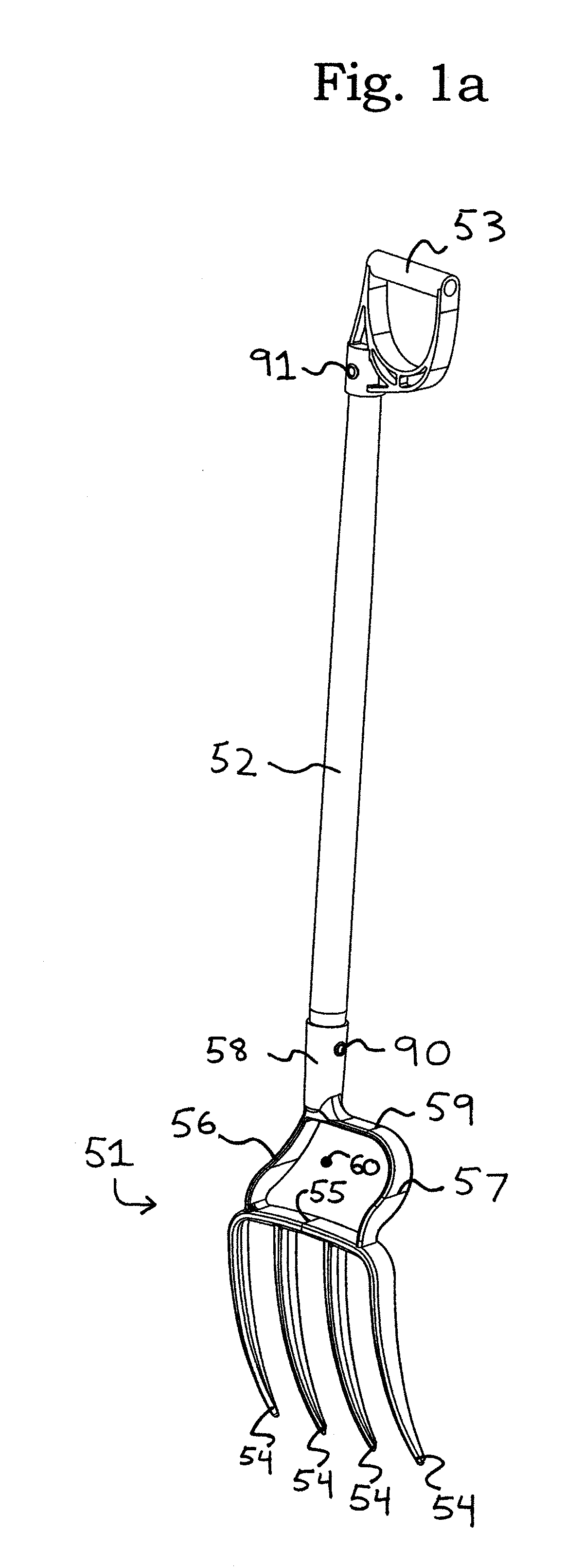Digging and Tilling Implements with Knee Clearance
a technology of digging and tilling implements, applied in the field of tools, can solve the problems of slipping of the user's foot from the tool shaft, failure to provide the clearance of the user's knee to the tool shaft, and the common design of the tool, so as to achieve greater resistance to bending loads, less bent and broken tines, and more efficiency in entering
- Summary
- Abstract
- Description
- Claims
- Application Information
AI Technical Summary
Benefits of technology
Problems solved by technology
Method used
Image
Examples
second embodiment
[0041]FIGS. 3a and 3b show a spading fork. In FIG. 3a, shaft 52 attaches to a tool head 151 via a socket 158 or other means of attachment. Head 151 may be fabricated by a variety of methods from a wide variety of materials, although this embodiment has been designed to be cast. A central step 155 acts as a structural cross bar to transfer the loads from the shaft to a plurality of tines 154. The foot of the user may be placed at the center of head 151 on central step 155 without interference with shaft 52 and the leg and / or knee of the user. A guide 161 serves to prevent the foot of the user from slipping sideways off central step 155.
[0042]In FIG. 3b, an offset 183 of a shaft centerline 181 from a tool head centerline 180 allows the knee and leg of the user to remain centered over tool head 151 during operation without interfering with shaft 52. In this embodiment, a handle centerline 182 is offset to align with a head centerline 180. This alignment is not necessary to realize most...
third embodiment
[0043]A third embodiment is illustrated in FIGS. 4a (perspective view), 4b (exploded view), and 4c (rear elevational view). FIG. 4a shows a tool head 201 designed to be fabricated by forging, stamping or other methods commonly used in fabrication with flat metal stock. Tool steels would be well suited to this application, although other ferrous and non-ferrous alloys would also be suitable. A plurality of tines 204 may be forged to match either cross-section shown in FIG. 2a or FIG. 2b, or may match the cross-section of conventional spading forks.
[0044]FIG. 4b shows that head 201 attaches to a shaft 202 through a spike 212 that is forced into the end of shaft 202 and gripped by a ferrule 213 in a manner commonly used in commercially available spading forks.
[0045]FIG. 4c shows an offset 233 of a shaft centerline 231 from a tool head centerline 230 that allows the user to apply force to a central step 205 without interference between the leg and knee of the user and shaft 202. Shaft 2...
PUM
 Login to View More
Login to View More Abstract
Description
Claims
Application Information
 Login to View More
Login to View More - R&D
- Intellectual Property
- Life Sciences
- Materials
- Tech Scout
- Unparalleled Data Quality
- Higher Quality Content
- 60% Fewer Hallucinations
Browse by: Latest US Patents, China's latest patents, Technical Efficacy Thesaurus, Application Domain, Technology Topic, Popular Technical Reports.
© 2025 PatSnap. All rights reserved.Legal|Privacy policy|Modern Slavery Act Transparency Statement|Sitemap|About US| Contact US: help@patsnap.com



